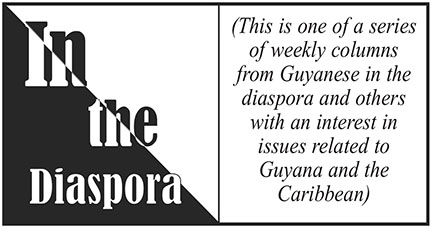Gabrielle Jamela Hosein is a feminist, activist, poet and Senior Lecturer at the University of the West Indies, and also writes a column in the Trinidad and Tobago Guardian
A shorter version of this column appeared in Trinidad and Tobago Newsday on Wednesday July 3, 2024.
This past week, we watched Hurricane Beryl pass through an alley of Caribbean islands. It was a surreal experience of tracking a moving disaster minute by minute, our thoughts with the most vulnerable, and our hopes that it will be downgraded accompanying our prayers.
If you are a Caribbean person, you would know we are brought together by cricket, carnivals, and hurricanes. That is when, across our many differences, our shared history and geography make our hearts celebrate with or break for each other as they do now for our sisters and brothers in Union Island, Mayreau, Petit Martinique, Carriacou, Canouan, Bequia, Jamaica, St. Vincent, Grenada, and Barbados, where individual homes, fishing boats, agricultural farms, and livelihoods were all wrecked, in some places worse than others.
We’ve seen this before in The Bahamas, Barbuda, Dominica and Puerto Rico after Irma and Maria in 2017 and Dorian in 2019. Maria was the deadliest Atlantic hurricane in a century. The Caribbean is becoming a postcolonial register of islands mutilated by storms that follow the same path as ships which once brought the enslaved and indentured. History comes to our shores again and again like the tides; the wealthy nations that profited from the slave trade and exploitation of indentured workers creating the climate crisis which threatens us with dispossession today.
Beryl is the first June hurricane to ever reach Category 5, the farthest east a storm has ever hit Category 4, and the first storm before September to go from tropical depression to major hurricane in under 48 hours. It is the earliest Category 5 hurricane ever recorded in the Atlantic basin, and it decimated Carriacou in “half an hour”. The satellite image of this tiny island smaller than an iris in the eye of Beryl is symbolic of how overwhelmed our nations will be.
There have always been hurricanes, named after the Taino god, Juracan. However, the sense of dread that now accompanies hurricane season, as it is expected to worsen because of manmade global warming, is something full of both greater terror and anger.
Anger at the fossil industry and governments that knew about global warming predictions decades ago, invalidated science and assassinated activists, suppressed renewable technology from becoming mainstream and breaking global dependence on oil and gas, and threw corporate social responsibility pennies and PR at communities, creating dependence on and loyalties to fossil giants rather than resistance movements. Such fury is vital to acknowledge as much as the mental distress and post-traumatic stress disorder (PTSD) that follows in the wake of hurricane destruction. On the one hand, there is ecological grief and emotions of sadness, frustration, distress, hopelessness and despair. However, ecological fury transforms these emotions into a matter of justice and urgent energy regime change.
Debris is how we measure the aftermath of a hurricane. Decapitated houses whose galvanised roofs are strewn across the landscape, electricity and telephone poles and wires angled toward or on the ground and trees lying across roadways. As Aliyah Khan writes in the Journal of West Indian Literature, “In Caribbean hurricane poetry and music, the security of the roof is a recurring theme representing the hurricane traumas of loss or home, life, and future that echo the identitarian insecurities of people who were colonized and deprived of their ancestral cultures.”
Yet, it is more than this. It is Caribbean people who are again being cast as disposable, as powerless to economic interests, as a people to whom the fossil industry can lay waste in order to profit. When we feel for each other, our emotional connection affirms that we matter. We are more than history and modernity’s debris.
Significant activism to stop fossil production through direct action and disruption, and legal challenges, has grown. Governments typically act as if these are fringe movements who don’t understand economics and are opposed to development, or are partisan and cannot be trusted, but ordinary people are mobilising to prevent planetary-scale, irreversible harm because we will pay the costs for profits that we will never see.
Part of the reason that radical tactics are used is because protest hardly makes news, and therefore finds it difficult to sufficiently kickstart debate, show the desperation of our times or mainstream clear demands. As one young woman from Just Stop Oil said in an interview, “I’ve been told so many times: Go to Parliament Square, go to an oil refinery or whatever. I’ve locked myself to an oil tanker for 36 hours. Nothing. I was just at Parliament Square for three days with 60,000 people, nothing happened. But my best friend throws soup on a Van Gogh and we’re in the news for months.” Besides grass-roots and feminist groups in our countries, you can join the Caribbean Youth Environmental Network, the Caribbean Youth Climate Justice Coalition and the Caribbean Climate Justice Alliance and get information from the Caribbean Climate Calabash, the Climate Conscious Podcast and Global Yaadie which present Caribbean climate change news. You can echo PM Mia Mottley’s call to cancel debt and finance a loss and damage fund, precisely because our governments will have to borrow at high premiums to rebuild, increasing indebtedness and impoverishing our economies.
We must demand every possible alternative that reduces global carbon footprint, support a new generation of leaders that understand ecology, make our own governments’ approach to resilience an election issue, and mainstream attacks against fossil capitalism. The legacy of our colonial history legitimises the radical protest necessary today. Do not give in to helplessness because of our small size. As we prayed for our sister isles, we must gather to fight for our lives.

